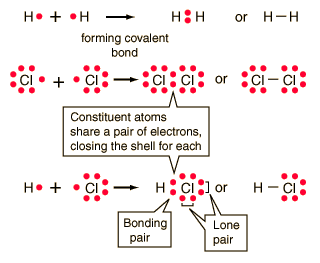Main article:
Covalent bondCovalent bonding is a common type of bonding, in which the electronegativity difference between the bonded atoms is small or non-existent. Bonds within most organic compounds are described as covalent. See sigma bonds and pi bonds for LCAO-description of such bonding.
[edit] Ionic bond
Ionic bonding is a type of electrostatic interaction between atoms which have a large electronegativity difference. There is no precise value that distinguishes ionic from covalent bonding but a difference of electronegativity of over 2.0 is likely to be ionic and a difference of less than 1.5 is likely to be covalent.[4] Ionic bonding leads to separate positive and negative ions. Ionic charges are commonly between −3e to +3e.
[edit] Polar covalent bond
Polar covalent bonding is intermediate in character between a covalent and an ionic bond.
[edit] Coordinate covalent bond
Coordinate covalent bonding, sometimes referred to as dative bonding, is a kind of covalent bonding, in which the covalent bonding electrons originate solely from one of the atoms, the electron-pair donor or Lewis base but are approximately equally shared in the formation of a covalent bond. This concept is somewhat fading as chemists increasingly embrace molecular orbital theory. Examples of coordinate covalent bonding occur in nitrones and ammonia borane. The arrangement is different from an ionic bond in that the electronegativity difference is small, resulting in covalency. They are shown by an arrow unlike other bonds. This arrow shows its head towards the electron acceptor or lewis acid and its tail towards the lewis base. This bond is seen in ammonium.
[edit] One- and three-electron bonds
Bonds with one or three electrons can be found in radical species, which have an odd number of electrons. The simplest example of a 1-electron bond is found in the hydrogen molecular cation, H2+. One-electron bonds often have about half the bond energy of a 2-electron bond, and are therefore called "half bonds". However, there are exceptions: in the case of dilithium, the bond is actually stronger for the 1-electron Li2+ than for the 2-electron Li2. This exception can be explained in terms of hybridization and inner-shell effects. [5]
The simplest example of three-electron bonding can be found in the helium dimer cation, He2+, and can also be considered a "half bond" because, in molecular orbital terms, the third electron is in an anti-bonding orbital which cancels out half of the bond formed by the other two electrons. Another example of a molecule containing a 3-electron bond, in addition to two 2-electron bonds, is nitric oxide, NO. The oxygen molecule, O2 can also be regarded as having two 3-electron bonds and one 2-electron bond, which accounts for its paramagnetism and its formal bond order of 2.[6]
Molecules with odd-electron bonds are usually highly reactive. These types of bond are only stable between atoms with similar electronegativities.[6]
[edit] Bent bonds
Bent bonds, also known as banana bonds, are bonds in strained or otherwise sterically hindered molecules whose binding orbitals are forced into a banana-like form. Bent bonds are often more susceptible to reactions than ordinary bonds.
[edit] 3c-2e and 3c-4e bonds
In three-center two-electron bonds ("3c-2e") three atoms share two electrons in bonding. This type of bonding occurs in electron deficient compounds like diborane. Each such bond (2 per molecule in diborane) contains a pair of electrons which connect the boron atoms to each other in a banana shape, with a proton (nucleus of a hydrogen atom) in the middle of the bond, sharing electrons with both boron atoms.
Three-center four-electron bonds ("3c-4e") also exist which explain the bonding in hypervalent molecules. In certain cluster compounds, so-called four-center two-electron bonds also have been postulated.
In certain conjugated π (pi) systems, such as benzene and other aromatic compounds (see below), and in conjugated network solids such as graphite, the electrons in the conjugated system of π-bonds are spread over as many nuclear centers as exist in the molecule or the network.
[edit] Aromatic bond
Main article:
AromaticityIn most cases, the locations of electrons cannot be simplified to simple lines (place for two electrons) or dots (a single electron). In aromatic bonds which occur in planar rings of atoms where the 4n+2 rule determines whether ring molecules would show extra stability.
In benzene, the prototypical aromatic compound, 18 bonding electrons bind 6 carbon atoms together to form a planar ring structure. The bond "order" (average number of bonds) between the different carbon atoms may be said to be (18/6)/2=1.5, but in this case the bonds are all identical from the chemical point of view. They may sometimes be written as single bonds alternating with double bonds, but the view of all ring bonds as being equivalently about 1.5 bonds in strength, is much closer to truth.
In the case of heterocyclic aromatics and substituted benzenes, the electronegativity differences between different parts of the ring may dominate the chemical behaviour of aromatic ring bonds, which otherwise are equivalent.
[edit] Metallic bond
Main article:
Metallic bondIn a metallic bond, bonding electrons are delocalized over a lattice of atoms. By contrast, in ionic compounds, the locations of the binding electrons and their charges are static. Because of delocalization or the free moving of electrons, it leads to the metallic properties such as conductivity, ductility and hardness.
[edit] Intermolecular bonding
There are four basic types of bonds that can be formed between two or more (otherwise non-associated) molecules, ions or atoms. Intermolecular forces cause molecules to be attracted or repulsed by each other. Often, these define some of the physical characteristics (such as the melting point) of a substance.
[edit] Permanent dipole to permanent dipole
A large electronegativity difference between two strongly bonded atoms within a molecule causes a dipole to form (a dipole is a pair of permanent partial charges). Dipoles will attract or repel each other.
[edit] Hydrogen bond
Main article:
Hydrogen bondIn some ways this is an especially strong example of a permanent dipole, as above. However, in the hydrogen bond, the hydrogen proton comes closer to being shared between target and donor atoms, in a three-center two-electron bond like that in diborane. Hydrogen bonds explain the relatively high boiling points of liquids like water, ammonia, and hydrogen fluoride, compared with their heavier counterparts in the same periodic table column.
[edit] Instantaneous dipole to induced dipole (van der Waals)
Instantaneous dipole to induced dipole, or van der Waals forces, are the weakest, but also the most prolific—occurring between all chemical substances. Imagine a helium atom: At any one point in time, the electron cloud around the (otherwise neutral) atom can be thought to be slightly imbalanced, with momentarily more negative charge on one side. This is referred to as an instantaneous dipole. This dipole, with its slight charge imbalance, may attract or repel the electrons within a neighbouring helium atom, setting up another dipole. The two atoms will be attracted for an instant, before the charge rebalances and the atoms move on.
[edit] Cation-pi interaction
Cation-pi interactions occur between the localized negative charge of π orbital electrons, located above and below the plane of an aromatic ring, and a positive charge.
[edit] Electrons in chemical bonds
In the (unrealistic) limit of "pure" ionic bonding, electrons are perfectly localized on one of the two atoms in the bond. Such bonds can be understood by classical physics. The forces between the atoms are characterized by isotropic continuum electrostatic potentials. Their magnitude is in simple proportion to the charge difference.
Covalent bonds are better understood by valence bond theory or molecular orbital theory. The properties of the atoms involved can be understood using concepts such as oxidation number. The electron density within a bond is not assigned to individual atoms, but is instead delocalized between atoms. In valence bond theory, the two electrons on the two atoms are coupled together with the bond strength depending on the overlap between them. In molecular orbital theory, the linear combination of atomic orbitals (LCAO) helps describe the delocalized molecular orbital structures and energies based on the atomic orbitals of the atoms they came from. Unlike pure ionic bonds, covalent bonds may have directed anisotropic properties. These may have their own names, such as Sigma and Pi bond.
In the general case, atoms form bonds that are intermediates between ionic and covalent, depending on the relative electronegativity of the atoms involved. This type of bond is sometimes called polar covalent.
[edit] References
- ^ Campbell, Neil A.; Brad Williamson; Robin J. Heyden (2006). Biology: Exploring Life. Boston, Massachusetts: Pearson Prentice Hall. ISBN 0-13-250882-6. http://www.phschool.com/el_marketing.html.
- ^ Laidler, K. J. (1993) The World of Physical Chemistry, Oxford University Press, p. 347
- ^ James, H. H.; A. S. Coolidge (1933). "The Ground State of the Hydrogen Molecule". Journal of Chemical Physics (American Institute of Physics) 1: 825–835. doi:10.1063/1.1749252.
- ^ Atkins, Peter; Loretta Jones (1997). Chemistry: Molecules, Matter and Change. New York: W. H. Freeman & Co.. pp. 294–295. ISBN 0-7167-3107-X.
- ^ Weinhold, F.; Landis, C. Valency and bonding, Cambridge, 2005; pp. 96-100.
- ^ a b Pauling, L. The Nature of the Chemical Bond. Cornell University Press, 1960.
[edit] External links
| [hide] Chemical bonds |
|
| "Strong" | |
|
| "Weak" | |
|
| other | |
|
| Note: the weakest strong bonds are not necessarily stronger than the strongest weak bonds |






 sodium (on the left) loses its one
sodium (on the left) loses its one  a positively charged sodium
a positively charged sodium 
 Water
Water 


